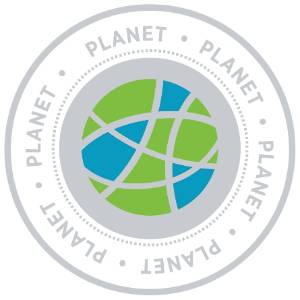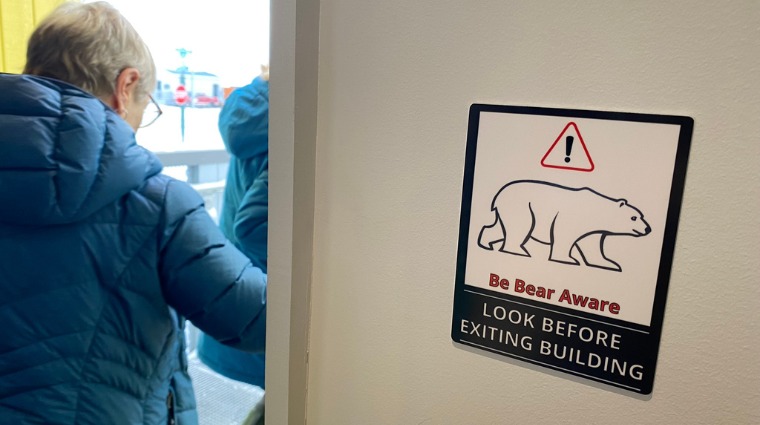
“Look left. Look right. Look up. Safe to proceed?” One of the first pieces of advice given to visitors to Churchill, Manitoba, where Saskatchewan Polytechnic recently travelled for its first Polar Bear Eco Trip, is about bear safety. Safety for people or safety for bears one might ask. “Ultimately both,” says Greg Fenty who co-led the trip. “People and bears co-exist in Churchill and we want to keep it that way. And polar bears are notorious climbers, which is why you need to look up!”
Churchill is located on the southwest shore of the Hudson Bay and on the Churchill River. The area is rich in cultural and historical knowledge and is a world-renowned site for natural ecology. Although polar bears are found in five countries, Churchill is the most accessible place to see them in the wild, making it a prime destination for polar bear viewing.
Sask Polytech’s group of 22 participants and two guides who made the trek more than a thousand kilometers north by van and then train arrived at the local station in the morning, found their luggage and loaded it on the shuttle that would take them to the Churchill Northern Studies Centre (CNSC) a half-hour drive from town. Before settling in, the group met with staff to go over safety protocols (Do not go outside by yourself!) and get a tour of the facility.
The CNSC is an independent, non-profit research station with both a research and education mandate. Its lab and accommodation facilities house visiting and in-house researchers and staff who provide contract research services to third parties. As part of its education mandate, the centre also accepts non-research visitors interested in learning about the area as overnight guests.
The CNSC was designed with safety and comfort in mind. “Being a sustainability-focused research centre, we built the facility with minimal impact as a goal,” says research coordinator Joni Reimer. We’ve got composting toilets and we operate an onsite micro-greens applied research project to supply fresh greens to the centre and address food security for the Churchill community.
Sask Polyech’s first Polar Bear Eco Trip had both a sustainability and life-long-learning mandate, so the CNSC made a natural landing spot for the group, who began their learning with lectures at Sask Polytech’s Saskatoon campus and by Zoom in the weeks leading up to the trip. “We were a little weary after our travels,” says Sandra Fowler who hails from rural southern Saskatchewan, “but it was exciting to arrive and meet the people who work and do research up in Churchill.”
Number one on the agenda for many participants was trying to be the first to spot a polar bear. “I was pretty sure we could see a couple of bears bedded down in the rocks behind the parking lot,” says Melanie Elliott, who co-led the trip. “It was very windy and hard to see, but the telltale off-white colour next to snow had us all wondering. A few of us sharing a room got out our binoculars but the jury was out—they could well have been lumps of blond limestone and dolomite.”
Day one in Churchill was indeed blustery and felt brutally cold as the wind off Hudson Bay swept through the area. The few trees in the tundra biome are mostly stunted pine with branches on only one side due to scarring from sand blown by prevailing winds. The joke in Churchill is you need four of them to make a Christmas tree.
After a chilly walk to visit historic Fort Churchill at Cape Merry and the beaches along the coast road, the group warmed up at St. Paul’s (1892)—the oldest church in the North still in use and the first prefabricated building in North America—which houses a stained-glass window commissioned by Lady Franklin to commemorate her husband Sir John Franklin, the famous Arctic explorer.
Over dinner in the cafeteria back at the CNSC, the group discussed what to wear for day two in Churchill. “The most important day of the whole trip is Tundra Buggy® day,” says Fenty. “We prepared everyone before the trip with what to bring and the importance of dressing in layers. After the first day’s gusty outing people were rethinking what they’d need for a day out viewing wildlife.”
As it turned out, Friday’s forecast was for less wind and the promise of sunshine—a rarity in Churchill in winter. Participant Diane Cross beamed as she remembered the group’s second day in the region. “We were so lucky! It was just a magical day with clear skies and sun, and much less cold than the day we arrived. We couldn’t have planned it better.”
The group arrived at the Frontiers North Adventures headquarters only a few kilometres from the CNSC in the early morning and climbed the stairs to enter the large polar bear viewing vehicle where they would spend the day. Tundra Buggies® are made from repurposed fire engine bases and are designed to keep people at a safe distance from polar bears. Frontiers North guide Natasha Grapes explained to the group that the buggies have minimal impact on the Churchill Wildlife Management Area because they stick to existing paths created by the Canadian military, which operated a naval base and backup rocket launch site there from the 1940s until the 1960s.
A whoop went up from the group as one participant (and author of this article) mis-identified another whiteish rock as the day’s first bear. Soon after, however, the real polar bear count would start. By sunset, the group had counted 20 bears, including a mother and cub. Grapes drove the winding paths through the management area with aplomb—a real talent considering the bumpy, semi-frozen permafrost she had to navigate—and managed to circle the buggy to find spots that would allow good bear viewing while not disturbing the apex predators as they went about their business. Some were bedded down for naps, others, likely teenaged males, sparred playfully. Bear spottings were most often individuals or pairs, but at one choice spot near the bay the group witnessed a rare citing of five bears in proximity and another two on the other side of the vehicle. Polar bears were the main attraction, but the group also spotted artic foxes, a lemming and pure white ptarmigan hopping about the low scrub.
“It was truly amazing to see these majestic creatures in the wild,” says Glen Solnicka who travelled with his friend Julia Coutts. “Going to Churchill to see polar bears has been on my bucket list for some time and this trip was such a rewarding way to fulfill that dream.” Coutts adds, “It’s hard to describe the feeling when you see something so few people see in their lifetime except in photos or video. They are just beautiful animals and mesmerizing to watch.”
Teacher Terri Jackson managed to connect with her grade one-two class at Lawson Heights school in Saskatoon during a rare moment of northern cellular connectivity while aboard the buggy. “Churchill is referred to as ‘the accessible arctic’ but I had no idea I’d be able to show my students what I was seeing live,” says Jackson. “I’m not sure who was more excited about sharing the experience, my students or me!”
“It was nice to see the bears looking relatively healthy and not too skinny,” noted Kathy Franko, who joined the trip from Watson, Saskatchewan. “We heard from a researcher at Polar Bears International in Churchill that this past spring was late and so bears had a relatively long time to hunt.”
Over time, however, research is showing that the bears have fewer freeze-up days, which means fewer days to catch seals. “I hate to say this,” says Sask Polytech student Zachary Reimer, who took time off from his Integrated Resource Management (IRM) program for the eco-trip, “but part of my desire to go on this tour was to see something that may not be around in my lifetime. I hope that’s not true, but it’s a possibility.”
Tundra Buggy® day is a tough act to follow but day three in Churchill got off to an interesting start with a lecture by Dr. Doug Clark, a University of Saskatchewan polar bear researcher currently living at the CNSC while conducting research on bear/human interaction using field cameras. “Skinny bears are dangerous bears. They have high motivation to predate on anything they can,” says Clark, confirming what the group heard at Polar Bears International. “My research now has enough data to start to understand what some of the drivers are for bear/human interactions. Sea ice extent affects how long the bears have to stay on shore, and this has a big effect on visitation.”
The rest of day three in Churchill was spent in and around town where participants spotted more wildlife (silver fox, cross fox, muskrat, snowy owl) and had free time to wander the main street in search of souvenirs and other sites—all while looking both ways. As it turns out, three polar bears were chased from town by local conservation officers that very day and as they noted, there would be many more in the days to come as Hudson Bay freezes and the bears make their way from the denning grounds down to the sea ice that starts to form in November.
The group made a final educational visit to the Itsanitaq museum—a local museum dedicated to Inuit culture with items dating from Pre-Dorset (1700 BC) through Dorset, Thule and modern Inuit times. “We’ve seen so much on this adventure,” says Scott Buckle, who travelled from Alberta to be part of the eco-trip. I’ve learned a lot and have enjoyed the whole experience.”
Boarding the train at the station after a group dinner in town, participants got comfortable once again for the long journey by train back to The Pas where they had left the vans that would take them back to Saskatoon. The Sask Polytech train car had a knitting and crochet section and a good number of the group joined in games to pass the time. “I like the train,” says Elliot. “It’s my preferred method for getting to and from this wonderful region. It’s a bit like going back in time. Everything’s slower. You can enjoy meals in the dining car, play cards, visit. It’s an enjoyable part of the trip for many participants.”
Read part one to learn more about how the trip came about, and part three, where we’ll share more about the three Sask Polytech students on the trip!
For more information about Sask Polytech’s Polar Bear Eco Trip, visit our website: Polar Bear Eco Trip.
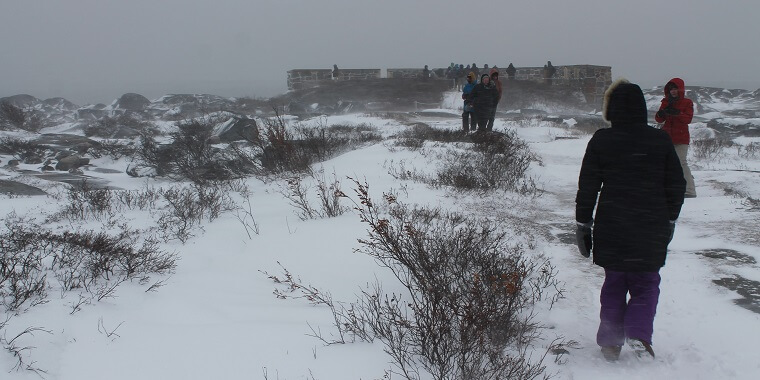
The group experienced blustery sub-Arctic weather at Fort Churchill on day one.
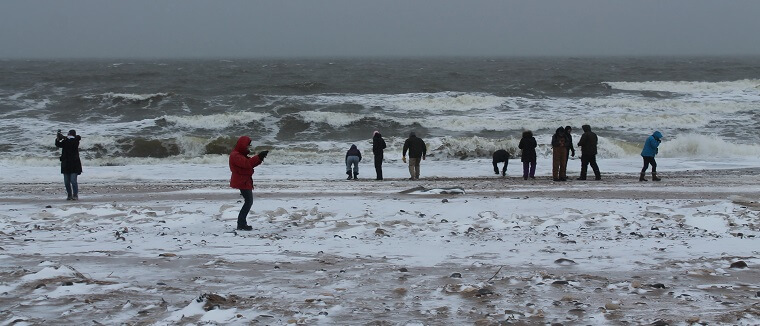
The wind whipping off Hudson Bay had everyone thinking about their clothing choices.
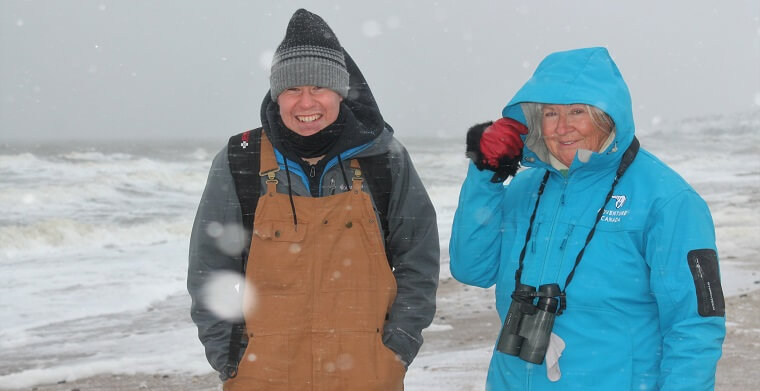
Guide Melanie Elliott and Sask Polytech student Zachary Reimer brave the wind on the beach at Cape Merry.
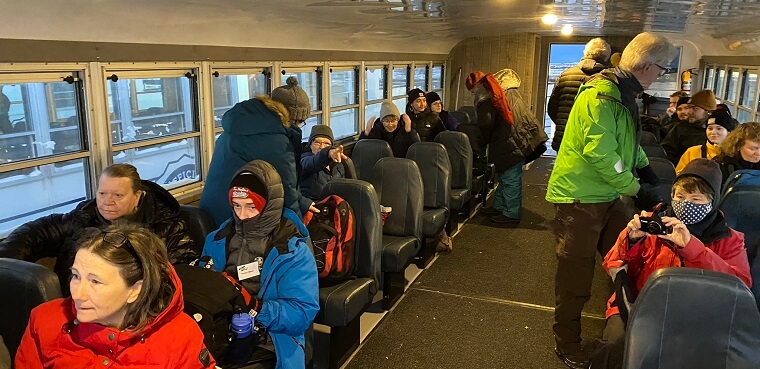
The group boarded the Tundra Buggy® for a full day of polar bear viewing in the protected Churchill
Wildlife Management area.
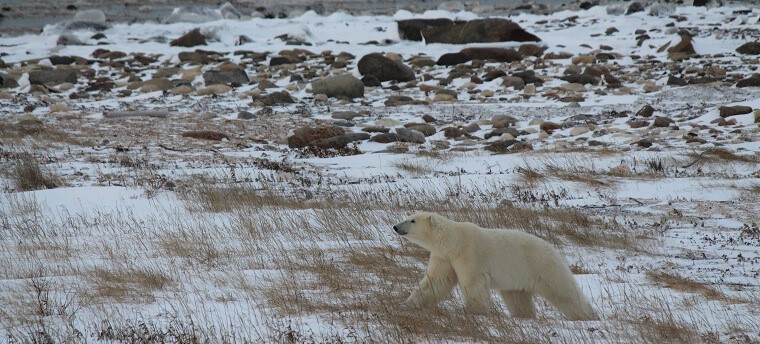
Early in the day the group spotted its first real, not-a-rock polar bear.
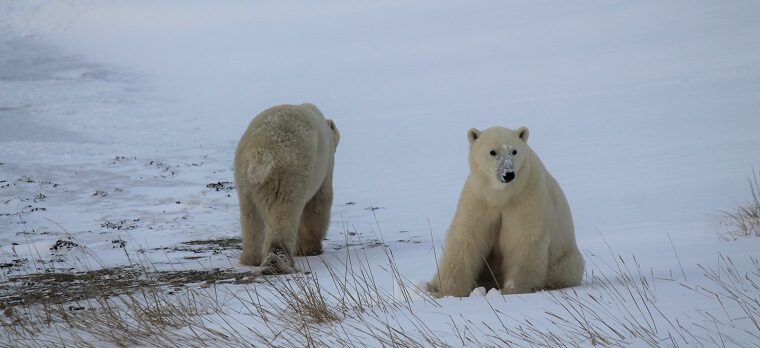
Lots of young bears, most likely siblings, were spotted in pairs.

The bears were passing time waiting for the sea ice to freeze enough to begin their hunting season. Young bears spar, or play fight, to practice hunting and establish hierarchy.
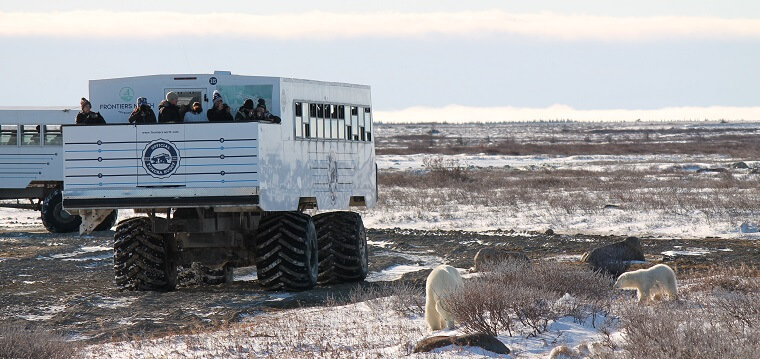
The Tundra Buggies® allow clear viewing through large windows and an outdoor observation
platform.
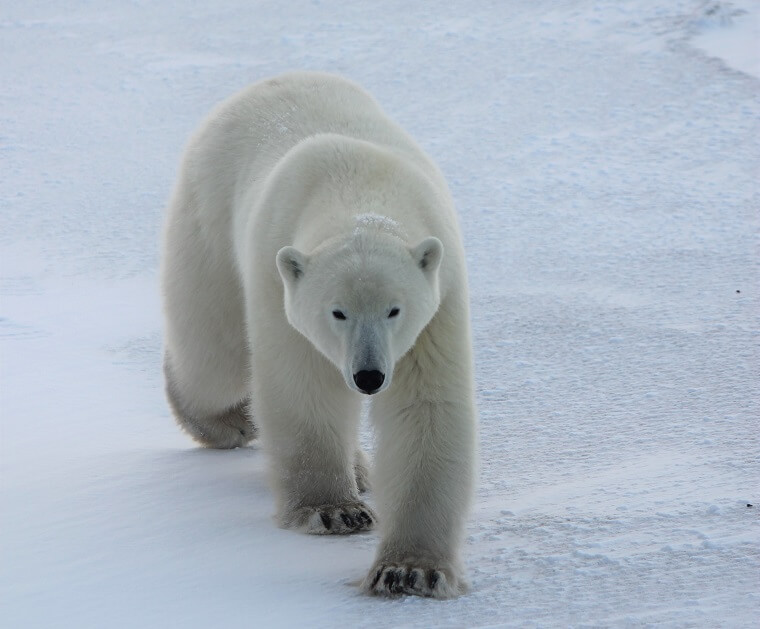
It was incredible to see these giant marine mammals up close in their natural environment.
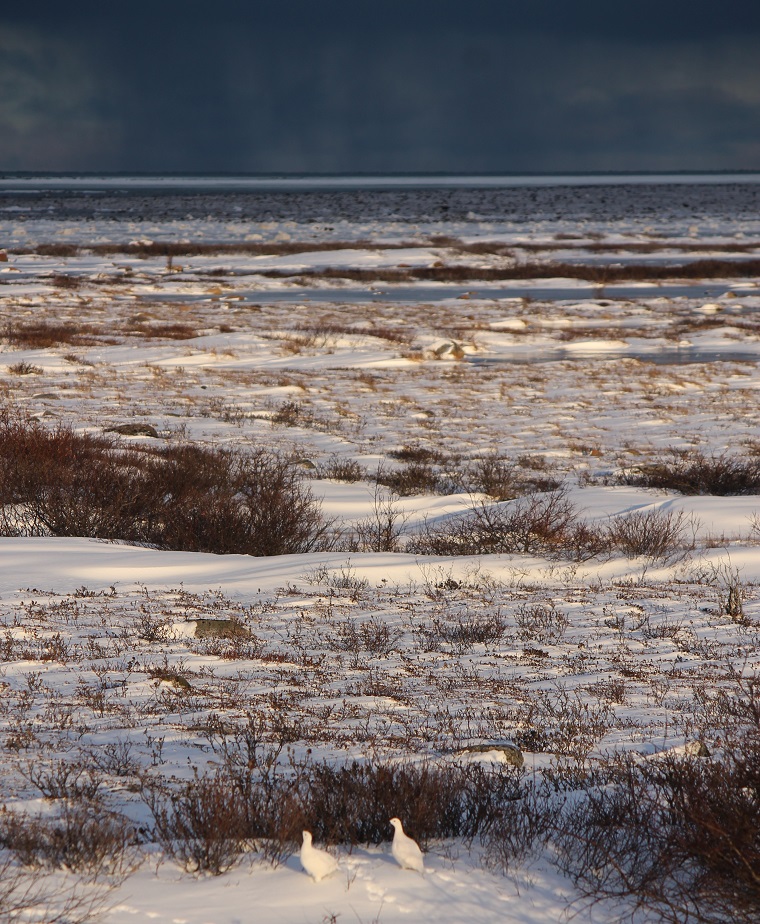
Snow-white ptarmigan hopped in the low scrub of the tundra.
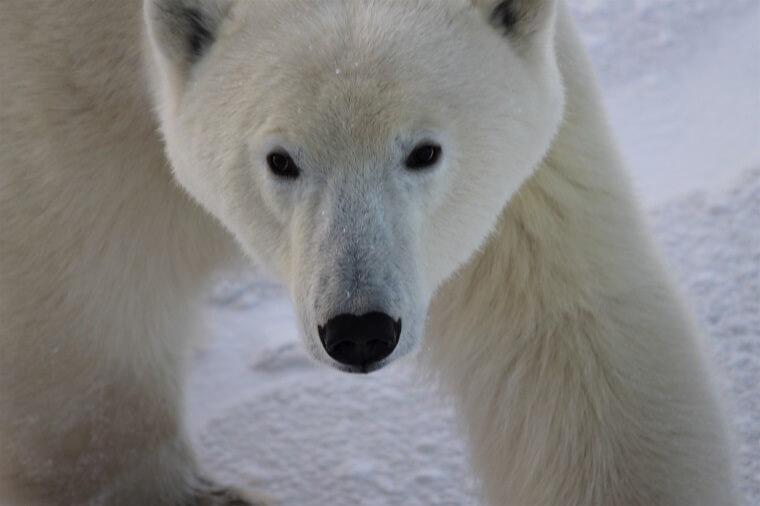
The bears were looking relatively healthy after the lean months of summer and fall spent on land.
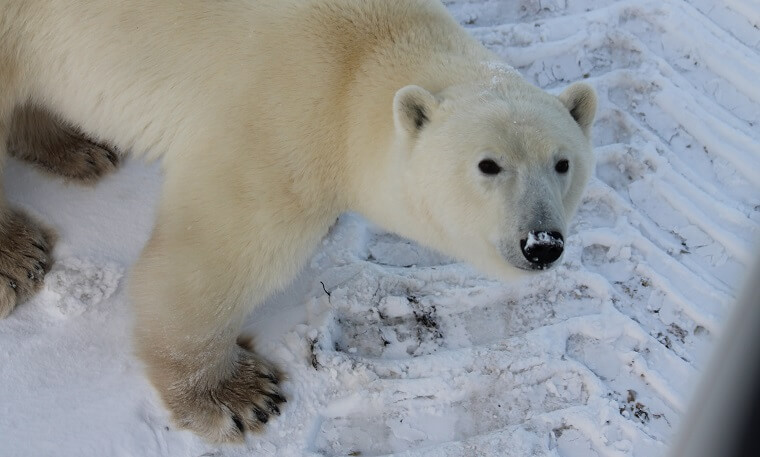
A curious young male approached the buggy and even stood on his hind legs to check us out.
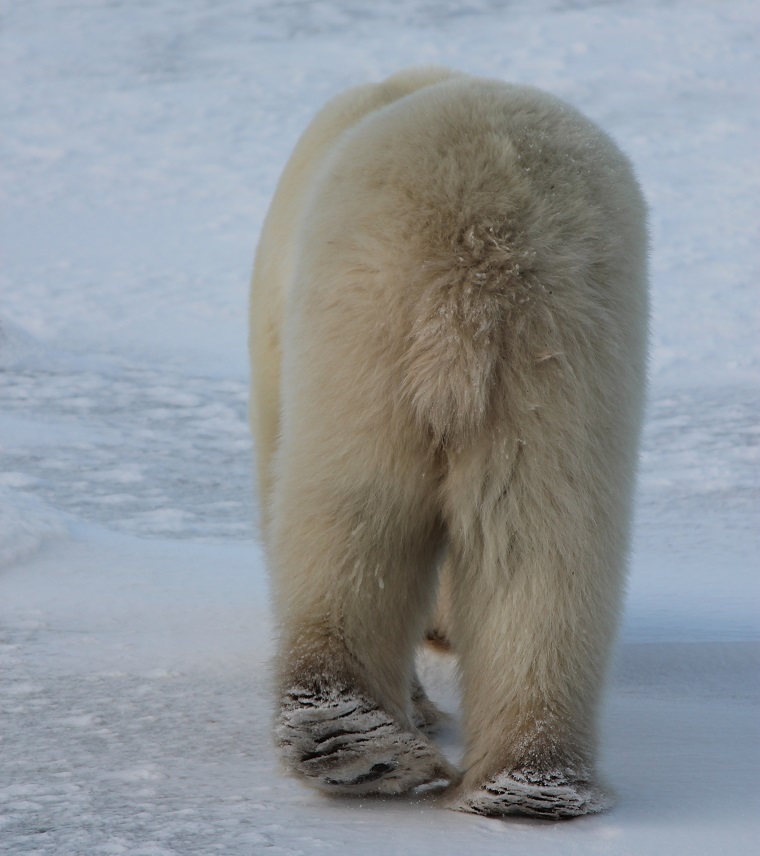
Unphased, he headed off in search of something more interesting.

The group was thrilled to see this mother and cub. Her radio collar will give researchers information about her whereabouts until it falls off after approximately one-and-a-half years.
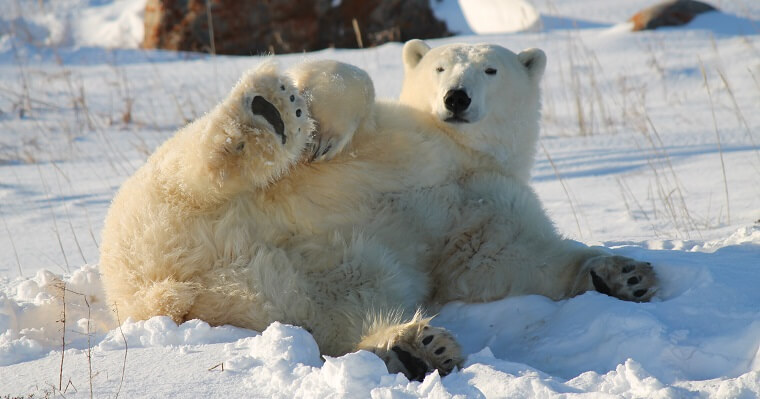
The sunny weather meant many bears were active. By mid-afternoon, some were in lounge mode.
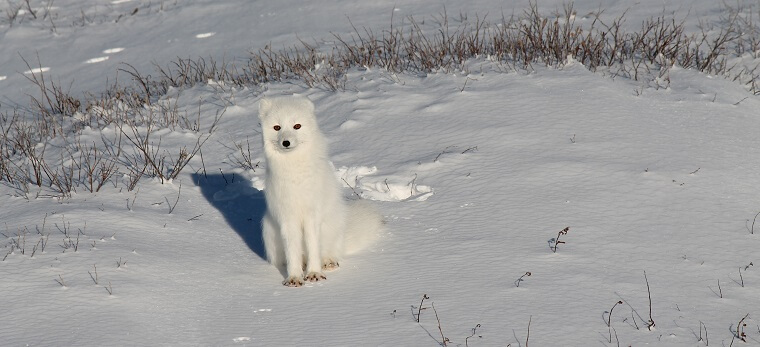
Participants were excited to see two Arctic foxes. This one posed before pursuing a lemming under the snow.
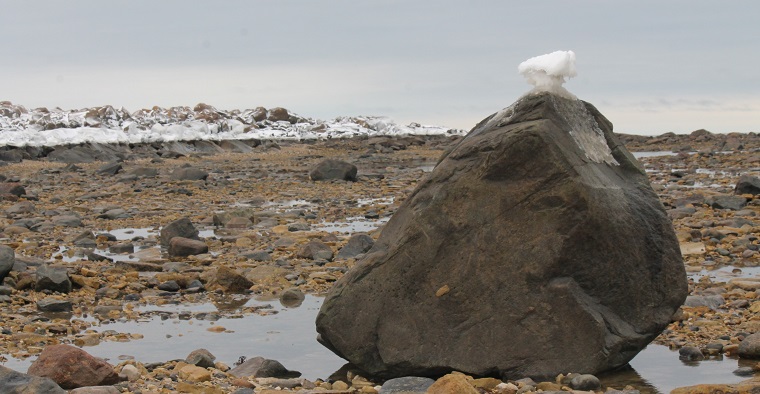
The tide was out during a final day's sightseeing trip to the beach.
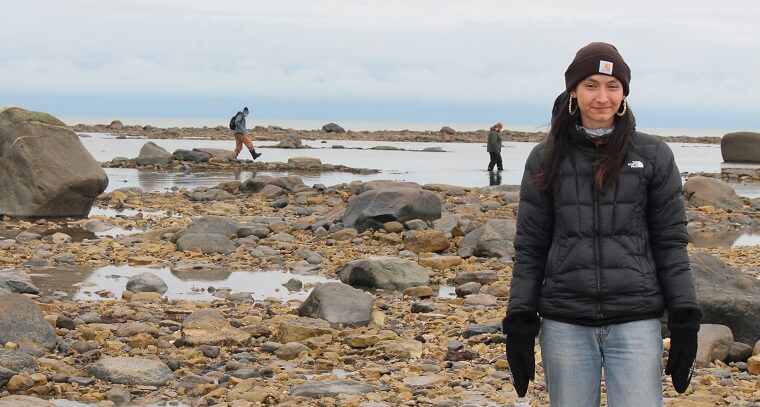
Participant Naomi Bird, who is pursuing graduate studies in land-based learning, was one of six students who took time from school for this unique learning opportunity.

A cross fox makes its way across the weathered, lichen-covered pre-Cambrian "whaleback" rock near Hudson Bay.
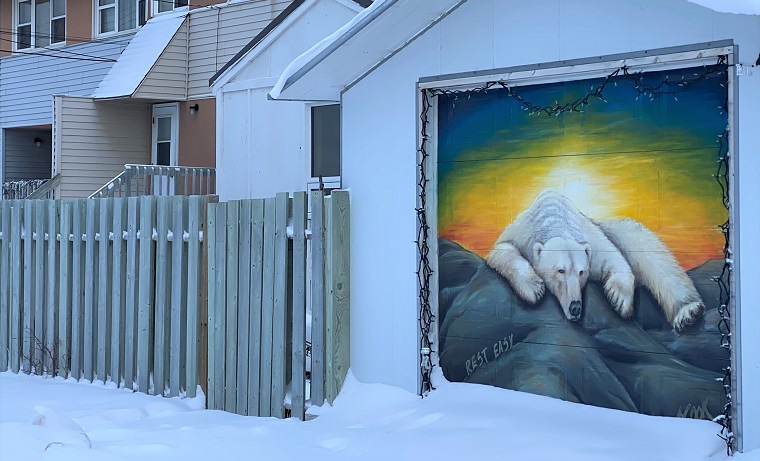
The polar bear is an iconic presence in the town of Churchill. Participants on Sask Polytech's first Polar Bear Eco Trip gained knowledge and a new respect for this king of the north. (Mural credit: artist Sandra Cook)
Saskatchewan Polytechnic is signatory to the SDG Accord. Sustainable Development Goal alignment is one of the ways Sask Polytech is leading the rise of polytechnic education.
